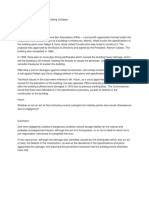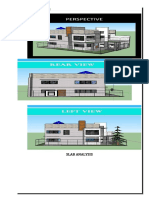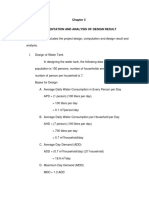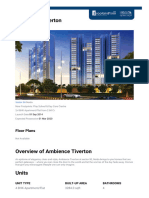Tutorial Set 1
Uploaded by
Issah IsmailaTutorial Set 1
Uploaded by
Issah IsmailaTUTORIAL SET 1
MC/EL/MN/MR 264 FLUID MECHANICS
1. A block of weight W slides down an inclined plane while lubricated by a thin film
of oil, as in Fig. P1.45. The film contact area is A and its thickness is h. Assuming a
linear velocity distribution in the film, derive an expression for the “terminal”
(zero-acceleration) velocity V of the block.
2. Find the terminal velocity of the block in Fig. P1.45 if the block mass is 6 kg, A
=35 cm2, ϴ= 15°, and the film is 1-mm-thick SAE 30 oil at 20°C.
3. A shaft 6.00 cm in diameter is being pushed axially through a bearing sleeve 6.02
cm in diameter and 40 cm long. The clearance, assumed uniform, is filled with oil
whose properties are ν = 0.003 m2/s and SG = 0.88. Estimate the force required
to pull the shaft at a steady velocity of 0.4 m/s.
4. Calculate the pressure in the ocean at a depth of 2000 m assuming that salt water
is (a) incompressible with a constant density of 1002 kg m−3, (b) compressible
with a bulk modulus of 2.05 GN m−2 and a density at the surface of 1002 kg m−3.
[(a) 19.66 MN m−2, (b) 19.75 MN m−2]
5. What will be (a) the gauge pressure, (b) the absolute pressure of water at a depth
of 12 m below the free surface? Assume the density of water to be 1000 kg m−3
and the atmospheric pressure 101 kN m−2.
[(a) 117.72 kN m−2, (b) 218.72 kN m−2]
6. What depth of oil, specific gravity 0.8, will produce a pressure of 120 kNm−2?
What would be the corresponding depth of water? [15.3 m, 12.2 m]
7. At what depth below the free surface of oil having a density of 600 kg m−3 will the
pressure be equal to 1 bar? [17 m]
8. What would be the pressure in kilonewtons per square metre if the equivalent
head is measured as 400 mm of (a) mercury of specific gravity 13.6, (b) water, (c)
oil of specific weight 7.9 kN m−3, (d ) a liquid of density 520 kg m−3?
[(a) 53.4 kN m−2, (b) 3.92 kN m−2, (c) 3.16 kN m−2, (d ) 2.04 kN m−2]
pg. 1 A.A. Kwarteng2014
9. A mass of 50 kg acts on a piston of area 100 cm2. What is the intensity of
pressure on the water in contact with the underside of the piston, if the piston is
in equilibrium? [4.905 × 104 N m−2]
10. The pressure head in a gas main at a point 120 m above sea level is equivalent to
180 mm of water. Assuming that the densities of air and gas remain constant and
equal to 1.202 kg m−3 and 0.561 kg m−3, respectively, what will be the pressure
head in millimetres of water at sea level? [103 mm]
11. A manometer connected to a pipe in which a fluid is flowing indicates a negative
gauge pressure head of 50mm of mercury. What is the absolute pressure in the
pipe in newtons per square metre if the atmospheric pressure is 1 bar? [93.3 kN
m−2]
12. An open tank contains oil of specific gravity 0.75 on top of water. If the depth of
oil is 2 m and the depth of water 3 m, calculate the gauge and absolute pressures
at the bottom of the tank when the atmospheric pressure is 1 bar.
[44.15 kN m−2, 144.15kN m−2]
13. A closed tank contains 0.5 m of mercury, 2 m of water, 3 m of oil of density 600 kg
m−3 and there is an air space above the oil. If the gauge pressure at the bottom of
the tank is 200 kN m−2, what is the pressure of the air at the top of the tank?
[96 kN m−2]
14. The system in Fig. P2.18 is at 20°C. If atmospheric pressure is 101.33 kPa and
the pressure at the bottom of the tank is 242 kPa, what is the specific gravity of
fluid X?
15. At 20°C gage A reads 350 kPa absolute. What is the height h of the water in cm?
What should gage B read in kPa absolute? See Fig. P2.21.
pg. 2 A.A. Kwarteng2014
16. The fuel gage for a gasoline tank in a car reads proportional to the bottom gage
pressure as in Fig. P2.22. If the tank is 30 cm deep and accidentally contains 2 cm
of water plus gasoline, how many centimeters of air remain at the top when the
gage erroneously reads “full’’?
17. For the inverted manometer of Fig. P2.32, all fluids are at 20°C.
If 𝑝𝐵 − 𝑝𝐴 = 97 𝑘𝑃𝑎, what must the height H be in m?
18. In Fig. P2.33 the pressure at point A is 25 lbf/in2. All fluids are at 20°C. What is
the air pressure in the closed chamber B, in Pa?
pg. 3 A.A. Kwarteng2014
19. Water flows upward in a pipe slanted at 30°, as in Fig. P2.35. The mercury
manometer reads h= 12 cm. Both fluids are at 20°C. What is the pressure
difference 𝑝1 − 𝑝2in the pipe?
20. In Fig. P2.36 both the tank and the tube are open to the atmosphere. If L _ 2.13
m, what is the angle of tilt θ of the tube?
21. An 8-cm-diameter piston compresses manometer oil into an inclined
7-mm-diameter tube, as shown in Fig. P2.39. When a weight W is added to the
top of the piston, the oil rises an additional distance of 10 cm up the tube, as
shown. How large is the weight, in N?
22. A pump slowly introduces mercury into the bottom of the closed tank in Fig.
P2.40. At the instant shown, the air pressure pB = 80 kPa. The pump stops when
the air pressure rises to 110 kPa. All fluids remain at 20°C. What will be the
manometer reading h at that time, in cm, if it is connected to standard sea-level
ambient air patm?
pg. 4 A.A. Kwarteng2014
You might also like
- Empower Your Heart With Breakthrough Nitric Oxide Therapy - Tammy Hester100% (3)Empower Your Heart With Breakthrough Nitric Oxide Therapy - Tammy Hester20 pages
- Quantity Takeoff - Cainta 2 Storey BuildingNo ratings yetQuantity Takeoff - Cainta 2 Storey Building3 pages
- CIV2040S Problem Set - 1 - Pressure and Its MeasurementNo ratings yetCIV2040S Problem Set - 1 - Pressure and Its Measurement6 pages
- Surveying: John Rey M. Pacturanan, CE, MPNo ratings yetSurveying: John Rey M. Pacturanan, CE, MP3 pages
- Besavilla Online Review - Quiz #2 Solution To Top 3 ProblemsNo ratings yetBesavilla Online Review - Quiz #2 Solution To Top 3 Problems7 pages
- Lecture 1 - Aggregates by MjcmonderondoNo ratings yetLecture 1 - Aggregates by Mjcmonderondo55 pages
- Philippine Bar Association Building CollapseNo ratings yetPhilippine Bar Association Building Collapse2 pages
- Prestressed Concrete Design SRDR5523: Manuel S. Enverga University FoundationNo ratings yetPrestressed Concrete Design SRDR5523: Manuel S. Enverga University Foundation7 pages
- CHB Connection Details: 1.0 General NotesNo ratings yetCHB Connection Details: 1.0 General Notes1 page
- 03-Experiment # 3-Hydrostatic Force On Plane Surfaces (12-18)No ratings yet03-Experiment # 3-Hydrostatic Force On Plane Surfaces (12-18)9 pages
- Compilation of Terms by Xpertz Ce ReviewNo ratings yetCompilation of Terms by Xpertz Ce Review34 pages
- Structural Theory Geometric Methods Supplementary NotesNo ratings yetStructural Theory Geometric Methods Supplementary Notes39 pages
- Answers to Problems for Principles of Foundation Engineering, 8th Edition by Braja M. DasNo ratings yetAnswers to Problems for Principles of Foundation Engineering, 8th Edition by Braja M. Das12 pages
- Construction Methods and Project Management100% (1)Construction Methods and Project Management7 pages
- A Proposed 8 Storey School Building Chapter 1 5 New Format Updated 012721 1No ratings yetA Proposed 8 Storey School Building Chapter 1 5 New Format Updated 012721 1486 pages
- Problem 827 - Continuous Beam by Three-Moment EquationNo ratings yetProblem 827 - Continuous Beam by Three-Moment Equation7 pages
- Numerical Methods and Implementation in Geotechnical Engineering – Part 1From EverandNumerical Methods and Implementation in Geotechnical Engineering – Part 1No ratings yet
- Electric-Fusion-Welded Steel Pipe For Atmospheric and Lower TemperaturesNo ratings yetElectric-Fusion-Welded Steel Pipe For Atmospheric and Lower Temperatures7 pages
- Accountant Controller Finance Analyst in Lakeland FL Resume Fernando BertolliNo ratings yetAccountant Controller Finance Analyst in Lakeland FL Resume Fernando Bertolli3 pages
- WK 3.1 Speaking - Pronunciation - Articulating English SoundsNo ratings yetWK 3.1 Speaking - Pronunciation - Articulating English Sounds13 pages
- Indicators, Sight, Liquid Level, Direct and Indirect Reading, Tubular Glass/PlasticNo ratings yetIndicators, Sight, Liquid Level, Direct and Indirect Reading, Tubular Glass/Plastic8 pages
- ICRI Guideline No. 310.1R-2008 - Guide for surface preparation for the repair of deteriorated concrete resulting from reinforcing steel corrosionNo ratings yetICRI Guideline No. 310.1R-2008 - Guide for surface preparation for the repair of deteriorated concrete resulting from reinforcing steel corrosion16 pages
- Overview of Mergers and Acquisition and MNo ratings yetOverview of Mergers and Acquisition and M11 pages
- 694739279-Physics-project-on-SemiconductorNo ratings yet694739279-Physics-project-on-Semiconductor25 pages
- Empower Your Heart With Breakthrough Nitric Oxide Therapy - Tammy HesterEmpower Your Heart With Breakthrough Nitric Oxide Therapy - Tammy Hester
- CIV2040S Problem Set - 1 - Pressure and Its MeasurementCIV2040S Problem Set - 1 - Pressure and Its Measurement
- Besavilla Online Review - Quiz #2 Solution To Top 3 ProblemsBesavilla Online Review - Quiz #2 Solution To Top 3 Problems
- Prestressed Concrete Design SRDR5523: Manuel S. Enverga University FoundationPrestressed Concrete Design SRDR5523: Manuel S. Enverga University Foundation
- 03-Experiment # 3-Hydrostatic Force On Plane Surfaces (12-18)03-Experiment # 3-Hydrostatic Force On Plane Surfaces (12-18)
- Structural Theory Geometric Methods Supplementary NotesStructural Theory Geometric Methods Supplementary Notes
- Answers to Problems for Principles of Foundation Engineering, 8th Edition by Braja M. DasAnswers to Problems for Principles of Foundation Engineering, 8th Edition by Braja M. Das
- A Proposed 8 Storey School Building Chapter 1 5 New Format Updated 012721 1A Proposed 8 Storey School Building Chapter 1 5 New Format Updated 012721 1
- Problem 827 - Continuous Beam by Three-Moment EquationProblem 827 - Continuous Beam by Three-Moment Equation
- Numerical Methods and Implementation in Geotechnical Engineering – Part 1From EverandNumerical Methods and Implementation in Geotechnical Engineering – Part 1
- Electric-Fusion-Welded Steel Pipe For Atmospheric and Lower TemperaturesElectric-Fusion-Welded Steel Pipe For Atmospheric and Lower Temperatures
- Accountant Controller Finance Analyst in Lakeland FL Resume Fernando BertolliAccountant Controller Finance Analyst in Lakeland FL Resume Fernando Bertolli
- WK 3.1 Speaking - Pronunciation - Articulating English SoundsWK 3.1 Speaking - Pronunciation - Articulating English Sounds
- Indicators, Sight, Liquid Level, Direct and Indirect Reading, Tubular Glass/PlasticIndicators, Sight, Liquid Level, Direct and Indirect Reading, Tubular Glass/Plastic
- ICRI Guideline No. 310.1R-2008 - Guide for surface preparation for the repair of deteriorated concrete resulting from reinforcing steel corrosionICRI Guideline No. 310.1R-2008 - Guide for surface preparation for the repair of deteriorated concrete resulting from reinforcing steel corrosion

























































































